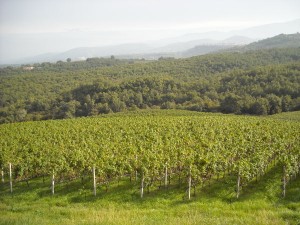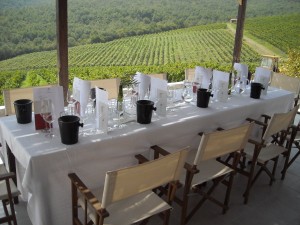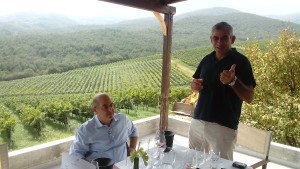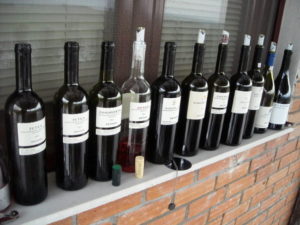Invited by the Wine Producers Association of Northern Greece and the wines importer Greka Terra, we’ve recently had the chance to visit some representative wine cellars from the land of Homer, a legendary Greek poet and rhapsodist known for the Iliad (Ἰλιάς) and the Odyssey (Ὀδύσσεια), whose famous words about wine „epi oinopa ponton” translate to „upon the wine-coloured sea”.
Many people have tried to decipher and understand the meaning of his words. For two and a half millennia, literary men have struggled to explain the red hue of Homer’s sea, when the blind bard from the Iliad was actually thinking of a muddy grey, ashen green, colour of the white wine, like the Greek Retsina at that time, which probably Ulysses used to drink, or just like the well known white Portuguese wine „Vinho Verde”, which literally means green wine.
At this time we didn’t plan to get deep into the history of Greek wines.  However, starting from some motives such as the tradition of the place, the wine growers’ ambition to promote the local varieties of wine grapes (and here we would like to mention Assirtyko, Moschofilero, Malagousia, Robola, Roditis, Tssaousi for the white ones and Xinomavro, Agiorghitiko, Mavrodaphne for the red ones) and finishing with wines that come from selected old vineyards, we can say that our southern neighbours truly understand that you cannot make yourself internationally renowned without something specific, traditional and representative.
However, starting from some motives such as the tradition of the place, the wine growers’ ambition to promote the local varieties of wine grapes (and here we would like to mention Assirtyko, Moschofilero, Malagousia, Robola, Roditis, Tssaousi for the white ones and Xinomavro, Agiorghitiko, Mavrodaphne for the red ones) and finishing with wines that come from selected old vineyards, we can say that our southern neighbours truly understand that you cannot make yourself internationally renowned without something specific, traditional and representative.
There are also international varieties in most of the vineyards (Sauvignon Blanc, Cabernet Sauvignon, Merlot, Syrah etc.) but they are mostly used for blending with Greek ones.
Today we have proposed to settle on one cellar Kir-Yianni, founded in 1997 by Yiannis Boutaris. The cellar from north-western Greece, Naoussa and Amyndeon to be more precise, continues at the base of the Vermio Mountains a long history and a family tradition, focusing on premium wines production according to consumers’ preferences and trends.
 Today, the Kir-Yianni team, under the administration of Stellios Boutaris, stick to a few basic principles which sum up their philosophy of quality wine-making: innovation, respect for tradition and expertise. At Kir-Yianni, selection is really crucial.
Today, the Kir-Yianni team, under the administration of Stellios Boutaris, stick to a few basic principles which sum up their philosophy of quality wine-making: innovation, respect for tradition and expertise. At Kir-Yianni, selection is really crucial.
The grapes are gathered separately even two or three times from the same parcel, manually sorted for fine selection before being introduced in the vinification process. Kir-Yianni is already well known for perseverance in the quality of the wines they make and for innovation and research (such as the quality and the type of oak used for ageing wine, origin, capacity, combustion level, pores’ dimension etc.).
Stellios Boutaris was telling us and convinced us, while tasting his wines together, that his primary objective is to create wines with special characteristics and unique, with intense but refined aromas, the right level of acidity to sustain evolution and ageing, balanced taste and versatile regarding the ease of matching them with a variety of dishes. We can even distinguish a unique style of vinification, specific to the Kir-Yianni cellar.
 Another remarkable thing to mention is that in Greece, big cellars support small wine growers, with modern production techniques, selling the wines of these producers, and even coaching. We will discuss about this more widely in the future. Kir-Yianni currently has approximately 50 ha of vineyard, growing the following varieties: Xinomavro, Cabernet Sauvignon, Merlot, Malbec, Syrah, Mavrodaphne, Tsapournakos, Negro Amaro, Chardonnay, Malagouzia, Gewurztraminer.
Another remarkable thing to mention is that in Greece, big cellars support small wine growers, with modern production techniques, selling the wines of these producers, and even coaching. We will discuss about this more widely in the future. Kir-Yianni currently has approximately 50 ha of vineyard, growing the following varieties: Xinomavro, Cabernet Sauvignon, Merlot, Malbec, Syrah, Mavrodaphne, Tsapournakos, Negro Amaro, Chardonnay, Malagouzia, Gewurztraminer.
Their wines are remarkable for their fruity aromas, acidity, corpulence and aromatic persistence. Let’s take a look at some of the wines which we believe will fit most of Romanian consumers’ preferences and which can make a great match with Mediterranean dishes.
Akakies Rose Sparkling 2013, which is obtained from Xinomavro, is fresh, fruity, constant, long persistent finish. Interestingly, the wine has a sugar moiety of 80g/l which is not noticeable and is very well integrated.
Akakies Rose 2013 (Xinomavro 100%) is a rose wine with fruity nose (strawberry, cherry) and slightly flowery, best for summer. It is attractive through it’s elegant taste in which we can distinguish citrus and red fruit completed by acidity and pleasant tannins.
Samaropetra 2013 is a blend of 50% Sauvignon Blanc and 50% Roditis, with a straw yellow colour, intense aromatic nose, in which we can find complex white flowers and peach. The attack has elegant characteristics in which citric, lychee and graprefruit are distinguishable. The aftertaste is long and persistent which makes an excellent wine for seafood and salads.
Taste-wise it took some of it’s personality from Xinomavro and it’s elegance and refinement from Merlot. Stored for 14 months in American and French oak barrels, and aged for another 6 months in bottles, the wine has a great potential considering the fact that it is still young. Next to red meat it makes a great match that will surprise you.
Ramnista 2010 (Xinomavro 100%), unveils a ruby dark red colour with a nose in which aromas of red fruits (strawberry, bitter cherry) interestingly complete the discrete flavours of vanilla and tomatoes. It has firm acidity but much more delicate finish, tannins are rather soft, highlighting the characteristics of the Xinomavro variety. The aftertaste of cherry, mushroom, vanilla and tobacco is long and persistent.
 Diaporos 2011 (Xinomavro 87%, Syrah 13%) is an expressive dry red wine, where the Xinomavro variety shows up its true potential, olfactive wise concentrated aromas of red fruits, flowers, vanilla, chocolate and pepper are easily noticeable. The taste is slightly spicy because of the Syrah but berries are more dominant.
Diaporos 2011 (Xinomavro 87%, Syrah 13%) is an expressive dry red wine, where the Xinomavro variety shows up its true potential, olfactive wise concentrated aromas of red fruits, flowers, vanilla, chocolate and pepper are easily noticeable. The taste is slightly spicy because of the Syrah but berries are more dominant.
It has a long finish where we have persistent aromas of black berries. After a few years of ageing it will become round, elegant and its rich characteristics will pop out. Don’t forget that the wine was stored for 22 months, being produced in a number of 12.000 bottles.
Μόνο καλό κρασί!










